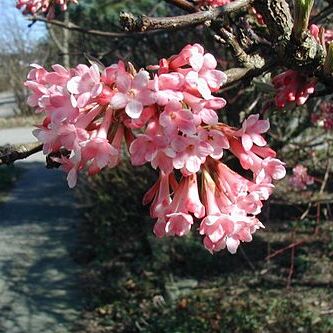Shrubs, deciduous, to 5 m tall. Bark gray-brownish. Branchlets of current year green, subglabrous; branchlets of previous year red-brownish, later gray-brownish or gray-whitish, terete, glabrous, with sparse, dispersed, small, rounded lenticels. Winter buds ellipsoid, with 2 or 3 pairs of separate scales; scales reddish brown, ciliate, apex acute. Leaves always opposite, not clustered at apices of branchlets; stipules absent; petiole purplish, robust, (1-)1.5-3 cm, adaxially pubescent on margin when young; leaf blade purplish green when young, elliptic or rhombic-obovate, 4-8 × 1-2.5 cm, papery, abaxially slightly pubescent on veins, adaxially sparsely pubescent with fine and short hairs when young, later glabrous on both surfaces but stellate-pubescent in axils of veins, midvein raised abaxially, lateral veins 5-7-jugate, pinnate, straight or slightly arched, branched, ending in teeth, raised abaxially, impressed adaxially, veinlets transverse, inconspicuous or slightly impressed on both surfaces, not lobed, base cuneate to broadly cuneate, without glands, margin triangular-serrate except at base, apex acute. Flowers appearing before leaves; inflorescence paniculate, at apices of short branchlets that can produce new leaves, 3-5 × 2.5-3.5 cm; rays opposite, decussate; first node of inflorescence with 2 rays, many flowered, sparsely pubescent when young, glabrescent, without large sterile radiant flowers; peduncles very short when flowers just open, later gradually elongated; bracts caducous, leaflike, reddish, linear-lanceolate, ciliate, subglabrous; bracteoles linear. Flowers on rays from 1st to 3rd orders, fragrant, sessile. Calyx reddish; tube tubular-obconical, ca. 2 mm, glabrous; lobes ovate, very small, ca. 0.5 mm, glabrous, apex obtuse. Corolla pink in bud, white when open, hypocrateriform, ca. 1 cm in diam., glabrous; tube 7-10 mm, slightly spreading in upper part; lobes spreading, broadly ovate, ca. 4 × 3 mm, apex rounded, margin entire. Stamens shorter than corolla, inserted above middle of corolla tube generally at different heights; filaments very short or absent; anthers yellow-whitish, subglobose, ca. 1.5 mm. Styles not exceeding calyx lobes; stigmas 3-lobed. Fruit initially turning yellow, maturing purple-reddish, oblong, 8-10 × ca. 6 mm, base rounded, apex rounded, glabrous; pyrenes compressed, oblong, ca. 7 × 5 mm, with 1 deep ventral groove, apex rounded. Fl. Apr-May, fr. Jun-Jul. 2n = 16*, 32*.
More
A shrub. It grows 3 m high and spreads 2.4 m wide. It is upright and loses its leaves during the year. The flowers are in clusters at the ends of branches. The flowers are white and can have pink tinges and have a scent. The fruit are red berries. It flowers in winter. The fruit are edible but the stones inside are poisonous.

